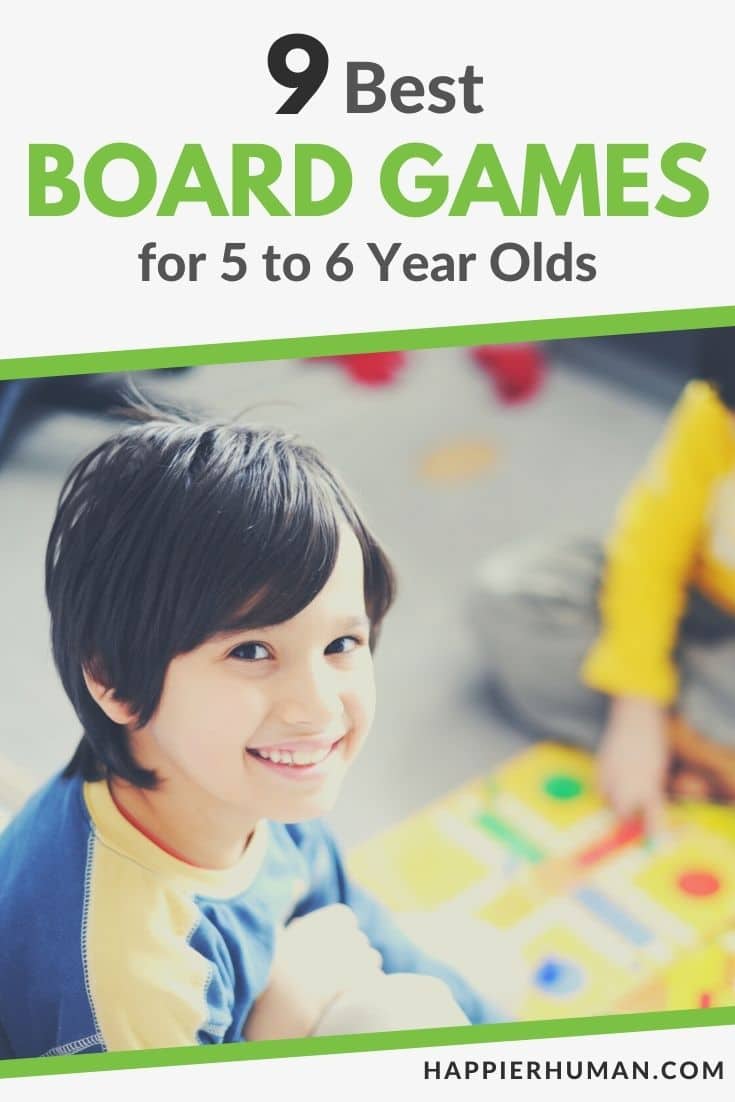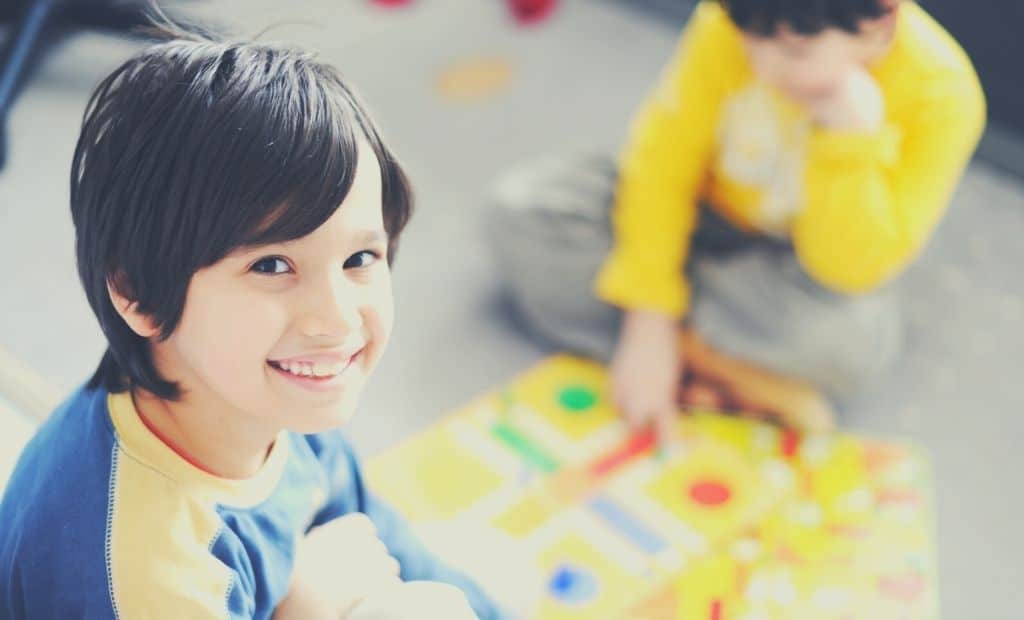There might be affiliate links on this page, which means we get a small commission of anything you buy. As an Amazon Associate we earn from qualifying purchases. Please do your own research before making any online purchase.
Are you looking for a board game for your five- or six-year-old kid?
Games play a vital role in early childhood development. In addition to hand-eye coordination, they also develop critical thinking skills, which are essential for pre-school children.
Board games offer opportunities for early strategic learning. They also boost language and mathematics skills, depending on the type of game. Likewise, they sharpen children’s focus and concentration, improving their mental clarity and memory.
And did you know that board games increase happiness, too?
Playing board games brings a lot of benefits, even at an early age. Research shows that it regulates anxiety and stress, increasing the chances of children experiencing delight and contentment.
In this post, we bring you the best board games for 5- and 6-year-old children. What’s exciting about these games is that they can all be played by adults, too, so you can add them to the table during family game nights.
Let’s check them out!
What You Will Learn
9 Best Board Games for 5- and 6-Year-Olds
1. Chutes and Ladders
Chutes and Ladders is a classic board game for children learning how to count and recognize numbers. While it is a perfect game for five- to six-year-old kids, it is also suitable for younger children.
In this game, the goal is to be the first person to reach the 100th square. Kids play by spinning the spinner and moving their pieces up and down the ladders and chutes. Whenever they land on a good deed, they have the chance to move higher by climbing the ladder. However, they need to watch out for chutes, as these could delay their progress.
Nearly 90 percent of reviewers give this game a five-star rating. They say that it doesn’t just teach children to count, it also develops their moral upbringing. Many parents like it because they played it when they were young.
Pros
Cons
2. Scrabble Junior
Scrabble Junior is another classic board game from Hasbro Gaming that is perfect for children who are learning letters and spelling. What’s somewhat unique about this kid’s version is that the board has two sides—an easy side and a challenging one. The easy side is for children still figuring out how to combine letters, and the goal is to form words by matching the letters with the clues on the board. The other side is for older children who already know more advanced words. It works like a regular Scrabble game, where the goal is to build your own words.
There are four tokens to play with to make the game more interesting: Green Letter Sprinter, Yellow Word Surfer, Blue DJ Word, and Red Wacky Word. You get a point and move your token along the track for each word you complete. If you complete a word that has the same color as your token, you get an additional point.
In the end, the player with the highest score is the winner. The more words a child knows, the greater their chances of winning. Hence, if you want your children to develop their vocabulary skills, we recommend Scrabble Junior.
Pros
Cons
3. Mouse Trap
Yet another classic board game from Hasbro Gaming, Mouse Trap has been around since the 1960s. This two- to four-player game is a test of not just counting and recognition skills, but also strategy and planning. It enhances creativity and critical thinking skills.
In this game, the primary goal is to create a mousetrap while collecting cheese wedges. However, you need to be careful not to fall into the other players’ traps. If your mouse gets trapped, you’re kicked out of the game. Whoever is the last remaining mouse wins the game.
Mouse Trap is best for five- to six-year-olds because this is the time when they need to develop their thinking skills. It is not recommended for children three years old and below because it has small components that they may choke on if left unattended.
Pros
Cons
4. Sequence for Kids
This classic board game is perfect for kids who are learning go read and enjoy playing without feeling pressured.
The game works like the adult version of Sequence, except it’s more playful and suitable for children. You also have a card (animal card) in your hand and a chip to place on the corresponding character on the board. The first player to build four chips in a row is the winner.
There are also wild cards that add excitement to the play. You can use a unicorn card to place a chip anywhere on the board, or you can use a dragon card to remove another player’s chip. Like the adult version, you can use corners as free spaces to build your sequence.
If your kid is having a hard time learning to read, but would like to play a board game, we recommend this version of Sequence. Even if it doesn’t develop their reading skills, it enhances logical thinking skills.
Pros
Cons
5. Ticket to Ride
Ticket to Ride is technically a board game for adults, but it is also suitable for very young children. This is because its rules and mechanics are simple and easy to understand. Plus, children get to learn a lot about the geography of North America.
The goal of this game is to connect the cities of North America by claiming all the railway routes and matching all the train cards. When claiming a route, the train cards need to be matched with the spaces on the board. There are also destination tickets and locomotive cards you can use to make special moves.
The player with the longest route wins. However, there are also secondary goals to complete, so even if you have the longest route, you may still lose the game if you have unaccomplished goals.
We recommend this board game to parents who want to play with their kids. It’s not as easy as the other board games on this list, but may still be played by five- to six-year-old children as long as there is parental guidance.
Pros
Cons
6. Catan Junior
If you want your kids to develop their strategic and critical thinking skills, Catan is highly recommended. Like the previous board game on this list, Catan is also most suitable for adults and older children, but the game mechanics are easy to understand, so it is a perfect fit for young children learning new skills.
Catan is a civilization game, which means that children get to build cities, trade goods, settle homes, and manage crops and fields. This board game can be a bit tricky and complicated if played by kids alone, so there should be proper guidance from adults. If you are looking for a fun yet challenging game for your kids, try out Catan.
Pros
Cons
7. The Floor is Lava
The Floor is Lava is an interactive game for kids, but it’s not your ordinary “board” game. Instead of sitting on the floor while playing, you have to set up the materials and place the board pieces (made of foam) on the floor. Thereafter, the kids must pretend that there is lava on the floor, and that falling off of the foam will cause them to get burned.
Obviously, a lot of physical activity is required to win this game. Although the rules are simple, the play itself can be difficult, as the players still need to draw challenge cards and perform specific actions without falling into the “lava,” Whoever reaches the safety zone without falling is the winner.
This game is great for both indoor and outdoor play. It provides fun and excitement for groups and parties, and a perfect opportunity to bond with kids during family gatherings. From a learning perspective, it boosts children’s ability to recognize colors and create strategies to keep themselves safe from the lava zone.
Pros
Cons
8. Qwirkle
Qwirkle is a fun way for kids to learn shapes and colors. It is a tile-based matching board game that comes in six different shapes and six different colors. This allows very young children to develop their spatial recognition, strategic planning, and problem-solving skills.
The rules of the game are simple—kids simply need to build lines by matching the tiles based on their shapes or colors. They earn points for every line they create and every match they make. What’s most interesting about this game, however, is the experience rather than the scoring. Children will surely feel engaged and challenged as they try to build more complex combinations.
This board game is a family favorite, as it is perfect for all ages. Even adults say that it is challenging and fun to play. It’s also relatively quick (around 45 minutes of gameplay), so you can play as many rounds as you like during game night.
Pros
Cons
9. Monopoly Junior
Monopoly Junior is just like the classic Monopoly game, as children get to buy, sell, and trade properties. The difference is that the properties are more child-friendly, like pet stores, candy stores, ice cream parlors, and skate parks. Likewise, the money involved is simpler and of smaller denominations, so they won’t have a hard time calculating.
Monopoly is a fun way to learn a lot of skills, particularly related to money. If you want to prepare your child for marketing, real estate, entrepreneurship, and the like, this game would be a good fit. Otherwise, they can still play it just for fun and entertainment.
Pros
Cons
Conclusion
We recommend you try these board games for your preschoolers. In addition to developing their mental skills, they also teach children how to compete and accept defeat graciously. They teach children to be calm and peaceful, and that failure is inevitable, but also something that can be dealt with.











